

www.farmboyzimsflightsims.com
FBZFS
Thanks For The Visit !
The Korean War (1950 - 1953) proved to be the test bed for two aircraft that would change the face of military aviation; the swept-wing F-86 Sabre and the Bell 47 Helicopter, military designation of H-13. Both of these aircraft are highly recognizable, and cut their teeth in the same war. They were developed out of the unique demands that arose from the Korean War.
During war, supply and demand is never more apparent, especially in the aviation industry. The technological advances in the fields of aerodynamics and engineering seem to take giant leaps forward during these times of crisis. Maintaining an edge over the enemy is of paramount importance. That advantage in air combat means the difference between life and death. In air combat, speed is usually the deciding factor that one looks for, along with maneuverability. Air combat is not the only field of
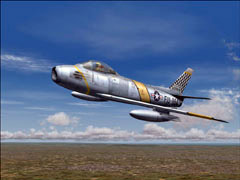
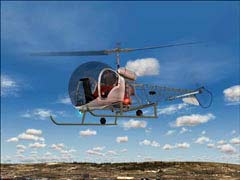
Korea
The F-86 Sabre and the Bell H-13 aka Bell Model 47
By Farmboyzim
aviation that leapt forward during this time. The science of helicopter flight was also being developed and perfected. The role of the helicopter has evolved at a breakneck pace as well, over the years. Initially, when the helicopter entered military service, it was used primarily for recon work and medical evacuation of casualties from front line areas.
Towards the end of WWII, the peninsula of Korea, which had been occupied by Japan during the war, was now being occupied by the United Soviet Socialist Republic (USSR). They were marching on down the peninsula when they happened to meet American Forces. To make a long winded, political story short (you’re welcome!), an agreement was made between the two countries to split this relatively unknown land in two, at the 38th parallel. The two countries that were created out of this agreement were the Democratic People’s Republic of Korea (DPRK) in the north and the Republic of Korea in the south.
On the 25th of June 1950, the North Korean People’s Army decided to punch across the 38th, on into the south. The Republic of Korea called out for help to the United Nations Security Council. Cessations to hostilities were called for, and went unanswered. Sixteen countries responded to South Korea’s request for help by supplying combat troops.
British warplanes off the west coast of Korea were flying off of four carriers. These early squadrons consisted of Sea Furies, Seafire’s, and Fireflies. As the war progressed, and more countries became involved, American Mustangs and Shooting Stars tangled with the North’s Yakovlev fighters. However, as the first winter gripped the country, the Chinese Communists entered the war along the Yalu River, which separated China from North Korea. With their involvement in the war, came the Soviet made, swept-wing MiG-15 fighter aircraft, with its notable reputation.
The answer to the challenge of the MiG-15 was the introduction of the F-86 Sabre, from North American. The first jet-to-jet aerial victory in military aviation history is attributed to an F-80, piloted by Lt. Russell J. Brown, when he brought down a MiG-15 on November 8, 1950. The Sabre, however, really stole the show, with its new, swept-wing design, speed, excellent maneuverability, and the ability to bring down the enemy, consistently. A wing of F-86A-5 aircraft arrived in Korea on December 13, 1950 making them the first Sabre jets sent to Korea. On December 17 the F-86 saw action against the incredible and unique MiG-15. Within two weeks, the Sabre had established a "kill ratio" of better than 8:1 over the MiG. The F-86 was nicknamed the “MiG Killer”, as this beauty proved to be the undoing of the MiG-15. The combat record of the Sabre speaks for itself. Of the 839 MiG-15’s shot
down during the Korean War, at least 800 were brought down out of the sky by Sabre pilots. Only 58 Sabre’s were downed by enemy pilots. A rather lopsided score, to say the least!
Korea was really the first conflict that jets were used so extensively in a fighter and bomber role. This was a new type of air war, to be sure. Tactics had to be changed. Speeds of closing aircraft were hitting in excess of 1000+ mph. That’s a bit faster than the Mustang and the Messerschmitt going head to head. Although the MiG was a fast, nimble fighter, the Americans used the F-86 to the max, having experience on their side. Knowing just how far you can push the aircraft, and yourself, can make all the difference between victory and defeat. To quote the actor Clint Eastwood in one of his many role’s (Big Fan here!), “A man’s gotta’ know his limitations”. The numbers of aircraft downed by each side clarifies this point.
As in WWII, the Korean War produced some Aces as well. Granted, not as many as in WWII, but you have to admit that this was a whole new shooting match! As you may know, to become an Ace, you must have at least 5 confirmed aerial victories. During the war in Korea, 40 pilots achieved the status of Ace. Thirty nine of the forty accomplished this feat in the F-86. The other Ace, a U.S.Navy Lieutenant, flew an F4U-5N to achieve this goal.
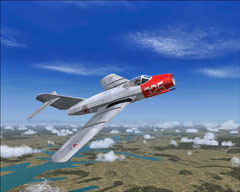
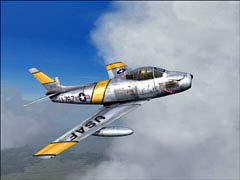
More than 6000 F-86’s were manufactured in both the Los Angeles and Columbus, Ohio divisions of North American Aviation. Four models of the fighter, the F-86A, E, F and H, were day fighters or fighter bombers, while the F-86D, K and L versions were all-weather interceptors. Further versions of the daylight models were fitted with more powerful engines, as well as beefed up armament. The F-86 was capable of handling canons, machine guns, rockets, and bombs. With a speed classification in the 650 mph range and a 600 mile combat radius, as well as a service ceiling of 45,000 feet, fighter intercept and cover took on an entirely new meaning.
On October 1, 1947, George Welch, a North American Test Pilot, flew the XF-86 for the first time, launching a new era for American fighter aircraft. The F-86 incorporated captured German research into its design, employing a 35-degree swept wing, thus delaying the onset of shock waves, which allowed for higher speeds to be attained. Automatic leading edge slots were also incorporated into the design. The Sabre overcame many problems since it’s initial flight in October of 1947, but still went on to become the USAF’s main fighter punch in the skies over Korea. Just a few months after the initial flight of the XF-86, Welch went
on to become the first pilot to fly the Sabre at Mach 1, the speed of sound. The Sabre was rated as sub-sonic, but it often grazed in the fields of Mach, just for the heck of it.
The controls of the Sabre were also a novel concept. In the F-86A, a booster control system was employed to assist in the control of the aircraft, but the pilot still had his hands full with controlling the jet. With later models, a full power-operated control system was employed to provide for better maneuverability at the higher speeds that were now being routinely attained. As for how the controls felt to the pilot, have you ever went from a vehicle with standard steering, into one with power steering? There’s quite the difference, especially if you have been used to muscling that old beast around for years. Jumping into the auto with power steering, you’re apt to over-steer, since not that much force is needed to turn the wheel. I think it may have been pretty much that way with the newer models of the Sabre. The designers employed some resistance in the controls to provide a sort of artificial feel, giving the pilot that conventional feeling in the stick that they may have been used to.
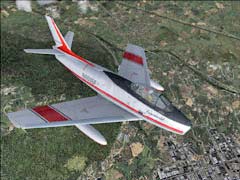
Aviation certainly went through some rapid, incredible changes, and the swept-wing fighter was the beginning of a design that was hard to improve upon, even to this day. The Sabre held speed records for six consecutive years and also went on to win several National Aircraft Show Bendix Trophies. The Sabre’s first official speed record was set in September of 1948, when an F-86A tore through the skies at a whopping 570 mph. 1952 saw this record bettered by an F-86D, with a speed of 698 mph. In 1953, the “D” model bettered its own record and was clocked at 715 mph. Keep in mind that just a few years before, speeds in the range of 300 - 400 mph were being achieved, and a few years before that, the thought of breaking 100 mph was simply grounds for getting you hauled off to the Happy Farm! U.S. production of the Sabre Jet ended in December 1956.

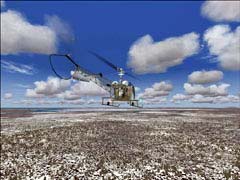
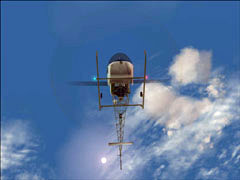
The Helicopter was a rather new concept, but like the fixed wing aircraft, the development raced ahead at astounding speeds. The most common image one may have these days, of the OH-13, also known as the Bell (model 47) H-13 Sioux, is those of the Medevac choppers in the long running television series, M.A.S.H. I think you may recognize the glass bubble with an erector set tail and stretchers on either side. That may be an overly simplified description, but I do think it fits. So, what happened in this war that was so different if the situation warranted that you bail out of your aircraft, or if you were a ground troop who had been injured? If you were lucky, you’d be seeing the bottom of the H-13 coming in to whisk you away to get patched up.
Arthur Young joined up with Bell back in 1941 and was the chief designer of the Bell 47. Over 5,600 were produced up to 1974, including 1200 under license to Italy, 239 in Japan, and 239 with the UK. The H-13 entered the Korean War in 1951 for reconnaissance, observation, and one of its more famous roles, a litter carrier. The 47 was dubbed the “Angel of Mercy” and you were most fortunate if you were on your
back and looked up to see the bottom side of this chopper. Over 18,000 casualties of the United Nations Forces were evacuated by the H-13. Two stretchers were attached to each of the skids, and the patient would be partially covered with a protective Plexiglas cover. This was a first for the military, being able to get the wounded evacuated in a more rapid fashion, by air. The H-13 went on to see some service in the early stages of the Vietnam War as well, until the OH-6A Cayuse was brought into service in 1968.
The H-13 has a single two-blade main rotor and a metal tow-bladed tail rotor. It could attain a speed of 106 mph or 92 knots. Franklin and Lycoming engines were used to power the various models of the 47, with horsepower ranging from around 200 to 260 hp. It wasn’t a Cobra or a Gazelle, but what it lacked in speed, it made up for in endurance and dependability. Numerous countries utilized the Bell 47 in many roles. The 47 went through many variations and improvements over the many years that it was produced. Once again, the 47 was being made up until 1974. I think Bell had a winner here.
I have to clue you in on three models that I know you will enjoy. The first is the Gmax F-86 Sabre for FS2004 by Kirk Olsson. Kirk is a one-man band and has put together an F-86 model that has been released as freeware and I can’t thank him enough! The quality of the model is excellent, with two variations of the F-86, the “Hard-Wing” version and a version with slats. Exterior and interior both display incredible attention to detail. The model also has animations. Watch for the pilot to duck his head when the canopy opens and closes. An absolutely spectacular model with 26 liveries, all exceptionally done. Kirk has also included some paint-help files for you repainters out there. The file name is sabrejet.zip. Excellent job Kirk, and THANKS!!!
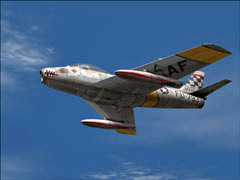
The other model is the Bell 47 with metal skids. Here’s one of the most detailed vintage helicopters I’ve come across. This model has an extremely detailed engine, which, of course, is in full view on the 47, along with a simple, yet authentic looking cockpit. This model is one of my favorite helicopter models to fly, as it has a good feeling to it, and allows for some excellent sightseeing, what with the bubble canopy
providing excellent visibility. The original design of the model is by Jean-Marie Mermaz, with some repaint and reworking of reflective textures and transparencies by John Blankenship. If you are into choppers, this is a must have model for your hanger! I spend quite a bit of time in this one. Thanks gang, for a beautiful chopper! File name of Bell47 Metal.zip.
The third model would be the MiG 15, serial 325, which was used by Colonel Yevgeny Pepelyayev of the 196th IAP / 324th IAD Antung AB 1951. The credit for this outstanding representation of the MiG 15 goes to Oldliner52, Jean-Pierre Langer, Jean-Pierre Bourgeois Benoit M. Dubé, and Marc Hardouin. Two liveries come with this package, one representing North Korea, and
the second is the livery of the USSR. Excellent detail in this model as well, with another great job to the MiG team! The file name is mig-15.zip.
These models are provided to the flight simming community as Freeware, and we all should be very grateful for these folks out there who enjoy sharing their hobby with all of us! Without them, I believe our virtual hangers wouldn’t be as virtually full! All three of these models can be downloaded by clicking on the above named zip files.
Hope you enjoyed the article, and have a great flight!!!
FBZ...


































































